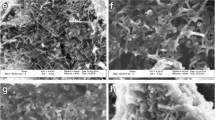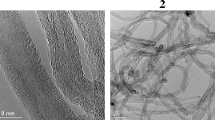Abstract
Dispersion of carbon nanotubes has been heavily studied due to its importance for their technical applications, toxic effects, and environmental impacts. Common electrolytes, such as sodium chloride and potassium chloride, promote agglomeration of nanoparticles in aqueous solutions. On the contrary, we discovered that acetic electrolytes enhanced the dispersion of multi-walled carbon nanotubes (MWCNTs) with carboxyl functional group through the strong hydrogen bond, which was confirmed by UV–Vis spectrometry, dispersion observations and aerosolization-quantification method. When concentrations of acetate electrolytes such as ammonium acetate (CH3CO2NH4) and sodium acetate (CH3CO2Na) were lower than 0.03 mol per liter, MWCNT suspensions showed better dispersion and had higher mobility in porous media. The effects by the acetic environment are also applicable to other nanoparticles with the carboxyl functional group, which was demonstrated with polystyrene latex particles as an example.











Similar content being viewed by others
References
Askari M, Abouie J (2011) A closed form for the electrostatic interaction between two rod-like charged objects. J Phys 23(15):155103–155108
Bahk YK, Buha J, Wang J (2013) Determination of geometrical length of airborne carbon nanotubes by electron microscopy, model calculation, and filtration method. Aerosol Sci Technol 47(7):776–784
Balasubramanian K, Burghar M (2005) Chemically functionalized carbon nanotubes. Small 1(2):180–192
Bentz J, Nir S (1981) Aggregation of colloidal particles modeled as a dynamical process. Proc Natl Acad Sci USA 78(3):1634–1647
Bhattacharjee S, Elimelech M, Borkovec M (1998) DLVO interaction between colloidal particles: beyond Derjaguin’s approximation. Croat Chem Acta 71:883–903
Bohidar HB, Bhakat P, Sharma J, Saxena A (2000) Anomalous colloidal stability of protein coated polystyrene latex beads studies by small angle light scattering. Int J Biol Macromol 27:111–116
Bunkin NF, Kiseleva OA, Lobeyev AV, Movchan TG, Ninham BW, Vinogradova OI (1997) Effect of salts and dissolved gas on optical cavitation near hydrophobic and hydrophilic surfaces. Langmuir 13:3024–3028
Fukasawa T, Adachi Y (2010) Direct observation on the Brownian coagulation of PSL particles through optical microscope in the regime near critical coagulation concentration (CCC). J Colloid Interf Sci 344(2):343–347
Goel A (2006) Colloidal chemistry. Discovery Publishing House, New Delhi
Grasso D, Subramaniam K, Butkus M, Strevett K, Bergendahl J (2002) A review of non-DLVO interactions in environmental colloidal systems. Rev Environ Sci BioTechnol 1:17–38
Heister E, Lamprecht C, Neves V, Tilmaciu C, Datas L, Flahaut E, Soula B, Hinterdorfer P, Coley HM, Silva SRP, McFadden J (2010) Higher dispersion efficacy of functionalized carbon nanotubes in chemical and biological environments. ACS Nano 4:2615–2626
Hu H, Zhao B, Itkis ME, Haddon RC (2003) nitric acid purification of single-walled carbon nanotubes. J Phys Chem B 107:13838–13842
Hyung H, Fortner JD, Hughes JB, Kim JH (2007) Natural organic matter stabilizes carbon nanotubes in the aqueous phase. Environ Sci Technol 41:179–184
Israelachvili JN, Pashley RM (1983) Molecular layering of water at surfaces and origin of repulsive hydration forces. Nature 306:249–250
Israelachvili JN, Wennerström H (1996) Role of hydration and water structure in biological and colloidal interactions. Nature 379:219–224
Jaisi DP, Elimelech M (2009) Single-walled carbon nanotubes exhibit limited transport in soil columns. Environ Sci Technol 43:9161–9166
Jeffrey GA (1997) An introduction to hydrogen bonding. Oxford University Press, New York
Jorgensen TC, Weatherley LR (2003) Ammonia removal from wastewater by ion exchange in the presence of organic contaminants. Water Res 37:1723–1728
Kennedy AJ, Hull MS, Steevens JA, Dontsova KM, Chappell MA, Gunter JC, Weiss CA Jr (2008) Factors influencing the partitioning and toxicity of nanotubes in the aquatic environment. Environ Toxicol Chem 27(9):1932–1941
Ling TY, Wang J, Pui DYH (2010) Measurement of retention efficiency of filters against nanoparticles in liquids using an aerosolization technique. Environ Sci Technol 44:774–779
Marcus Y (1991) Thermodynamics of solvation of ions: Part 5. Gibbs free energy of hydration at 298.15 K. J Chem Soc Faraday Trans 87(18):2995–2999
Masliyah JH, Bhattacharjee S (2006) Electrokinetic and colloid transport phenomena. John Wiley & Sons, Hoboken
Ninham BW, Kurihara K, Vinogradova OI (1997) Hydrophobicity, specific ion adsorption and reactivity. Colloids Surf A 123–124:7–12
Parks GA (1990) Surface energy and adsorption at mineral-water interfaces: an introduction. Rev Mineral Geochem 23:133–175
Pauling L (1960) The nature of the chemical bond. Cornell University Press, Ithaca
Peng X, Jia J, Gong X, Luan Z, Fan B (2009) Aqueous stability of oxidized carbon nanotubes and the precipitation by salts. J Hazard Mater 165:1239–1242
Premkumar T, Mezzenga R, Geckeler KE (2012) Carbon nanotubes in the liquid phase: addressing the issue of dispersion. Small 8(9):1299–1313
Schwarzenbach RP, Gschwend PM, Imboden DM (1993) Environmental organic chemistry. John Wiley & Sons, New York
Shieh Y, Liu G, Wu H, Lee C (2007) Effect of polarity and pH on the solubility of acid-treated carbon nanotubes in different media. Carbon 45:1880–1890
Shieh YT, Chen JY, Twu YK, Chen WJ (2012) The effect of pH and ionic strength on the dispersion of carbon nanotubes in poly (acrylic acid) solutions. Polym Int 61:554–559
Smith B, Wepasnich K, Schrote KE, Bertele AR, Ball WP, O’Melia C, Fairbrother DH (2009) Colloidal properties of aqueous suspensions of acid-treated, multi-walled carbon nanotubes. Environ Sci Technol 43:819–825
Steiner T (2002) The hydrogen bond in the solid state. Angew Chem Int Ed Engl 41(1):49–76
Sun X, Liu Z, Welsher K, Robinson JT, Goodwin A, Zaric S, Dai H (2008) Nano-graphene oxide for cellular imaging and drug delivery. Nano Res 1(3):203–212
Takayasu MM, Galembeck F (1993) Polystyrene latex coagulation: a study using centrifugation in density gradients. J Colloid Interf Sci 155:16–22
Tansel B, Sager J, Rector T, Garland J, Strayer R, Lanfang L, Roberts M, Hummerick M, Bauer J (2006) Significance of hydrated radius and hydration shells on ionic permeability during nanofiltration in dead end and cross flow modes. Sep Purif Technol 51:40–47
Volder MFL, Tawfick SH, Baughman RH, Hart AJ (2013) Carbon nanotubes: present and future commercial applications. Science 339:535–539
Wick P, Manser P, Limbach LK, Dettlaff-Weglikowska U, Krumeich F, Roth S, Stark WJ, Bruinink A (2007) The degree and kind of agglomeration affect carbon nanotube cytotoxicity. Toxicol Lett 168:121–131
Wu L, Gao B, Tian Y, Muñoz-Carpena R, Zigler KJ (2013) DLVO interactions of carbon nanotubes with isotropic planar surfaces. Lagnmuir 29:3976–3988
Zhang J, Zou H, Qing Q, Yang Y, Li Y, Liu Z, Guo X, Du Z (2003) Effect of chemical oxidation on the structure of single-walled carbon nanotubes. J Phys Chem B 107:3712–3718
Zhang K, Heo N, Shi X, Park JH (2013) Chemically modified graphene oxide-wrapped quasi-micro Ag decorated silver trimolybdate nanowires for photocatalytic applications. J Phys Chem C 117(45):24023–24032
Acknowledgments
This study was partially supported by the Swiss National Science Foundation (NFP 64), “Evaluation platform for safety and environment risks of carbon nanotube reinforce nanocomposites,” 406440_131286.
Author information
Authors and Affiliations
Corresponding author
Electronic supplementary material
Below is the link to the electronic supplementary material.
Rights and permissions
About this article
Cite this article
Bahk, Y.K., He, X., Gitsis, E. et al. Enhanced dispersion stability and mobility of carboxyl-functionalized carbon nanotubes in aqueous solutions through strong hydrogen bonds. J Nanopart Res 17, 396 (2015). https://doi.org/10.1007/s11051-015-3203-2
Received:
Accepted:
Published:
DOI: https://doi.org/10.1007/s11051-015-3203-2




